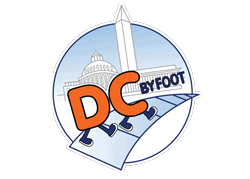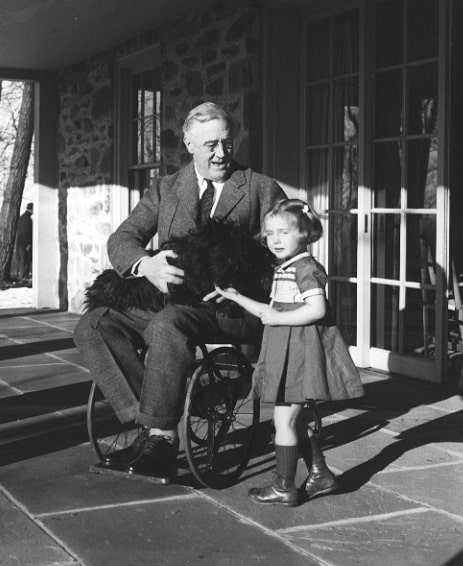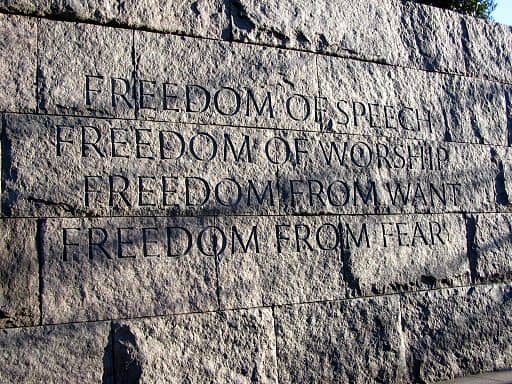This post is a guide to the Franklin Delano Roosevelt (FDR) Memorial in Washington, DC, with tips on planning your visit as well as a self-guided walkthrough.
- Introduction
- Plan Your Visit
- Design Walk-Thru
- Other DC Memorials
- Things to Do in DC
- Kostenlose Touren zu Fuß
This memorial is dedicated to the 32nd President of the United States, Franklin Delano Roosevelt.
FDR was a central figure of the 20th century during a time of unprecedented economic crisis and world war.
He is also the only US President to have been elected to more than two terms in office.
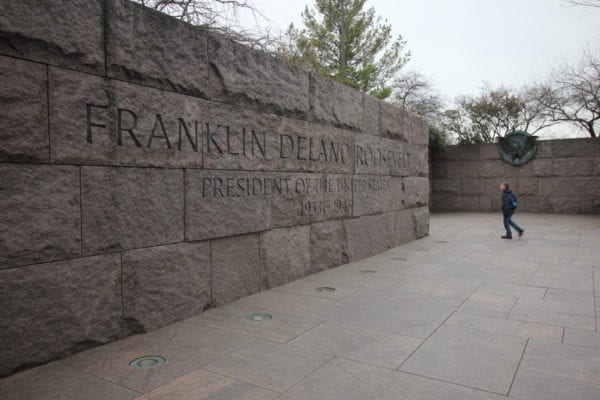
The memorial chronicles FDR’s twelve years in office, from 1933 to 1945, through a series of sections designed to feel like rooms, spread out over 7.5 acres (3 ha).
Each room depicts one of FDR’s Presidential terms and the historical events that took place during that time, through quotes, sculpture, and landscape elements.
The memorial is built from South Dakota granite punctuated by waterfalls, alcoves, and flowering Cherry Trees.
The memorial was designed by famed landscape architect Lawrence Halprin and was completed in 1997.
Operating Hours
The FDR Memorial is open 24 hours a day and National Park Service Rangers are on duty from 9:30 a.m. until 11:30 p.m. daily (except for Christmas Day) to answer questions.
The memorial book shop and gift store is open daily from 9 am until 6 pm.

The bookshop is located within a small visitor center, where you could pick up brochures about the memorial, view a memorial map, and see a replica of FDR's wheelchair.
Rangers also provide interpretive programs every hour on the hour from 10 am to 11 pm.
How to Get Here
The Franklin Delano Roosevelt Memorial is located on the west shore of the Tidal Basin, at 400 West Basin Drive SW, just south of the Martin Luther King Jr. Memorial (map).

Due to its location, you might find it beneficial to also plan to visit other memorials that are adjacent or nearby, such as:
- Thomas Jefferson Memorial
- MLK Memorial
- Lincoln Memorial
- Korean War Veterans Memorial
- Vietnam Veterans Memorial
Be sure to read our guide to all memorials and monuments in Washington, DC.
Public Transit
The nearest Metro subway station is the Smithsonian Metro Station and can be accessed by the BLUE, ORANGE, OR SILVER Metro lines.
You will need to walk for approximately 20 minutes, or 1 mile, to reach the memorial.
We recommend taking advantage of the Circulator Bus's National Mall route. The Circulator is a free bus option that makes a stop right in front of the FDR Memorial.
Alternatively, if you are considering purchasing a hop-on-hop-off bus ticket, keep in mind that all tours make a stop at the memorial.
Parking
Parking can be found along Ohio Drive to the west of the memorial and West Basin Drive to the north. There is a drop-off zone in front of the memorial on West Basin Drive.
Additional parking is located behind the Jefferson Memorial along Ohio Drive in parking lots A, B, and C.
There are a few commercial parking facilities in the area. You can pay online ahead of time for a guaranteed space with SpotHero.
To reserve your parking spot, visit the National Mall SpotHero Parking Page and book a spot with rates up to 50% off drive-up.
New to SpotHero? Click here to download the SpotHero app.
Accessibility/Bathrooms
The Franklin Delano Roosevelt Memorial is fully handicap accessible.
There is a vehicular drop-off point on West Basin Drive and wheelchairs can be borrowed from the visitor’s center/bookstore near the entrance.

There are also Braille captions throughout the memorial. Bathrooms are located behind the visitor’s center and near the south exit of the memorial.
Tours of the FDR Memorial
- Guided Tours - The FDR Memorial is a stop on our Tidal Basin Memorials tour and our All in One tour.
- Ranger Talks – Park Rangers provide free “interpretive programs” upon request when on duty.
- App - The Park Service also offers a visitor’s app for the National Mall for both Android and iPhone.
In addition to our tours of DC's Memorials and Moneument, we offer many more tours.
There are also several sightseeing bus tours, bike toursund Segway tours that offer guided walks as part of their tours, including walks of the memorial.
FDR MEMORIAL DESIGN EXPLAINED
Before we start the walk-through, there are a few important design features that are important to understanding the memorial.
First, keeping in mind FDR’s own physical impairments, the memorial's head designer, Lawerence Halprin, who himself was physically impaired, strongly considered accessibility in the design of the memorial.
FDR was stricken with polio at age 39 and lost the use of his legs; he was wheelchair-bound for his entire presidency.
The memorial was the first to be built wheelchair accessible and includes a system of low ramps, tactile reliefs, and Braille writing.
Second, there are a number of symbolic water features that change in size and volume as you move through the memorial.
The waterfalls are intended to symbolize the increasing tumultuousness surrounding FDR’s presidency, marked by the Great Depression, World War II, and Roosevelt’s death in 1945.
The use of water was symbolic and each room has a different water feature.
Third, the stone walls also reflect these historical changes, becoming more rough-hewn as visitors move through FDR’s four terms.
Fourth, the memorial includes sculptures depicting notable imagery during FDR’s presidency, such as a bread line and fireside chat.
There is also a sculpture of First Lady Eleanor Roosevelt honoring her dedication to the United Nations, making the FDR Memorial the only Presidential memorial to include the First Lady.
Finally, the memorial features 21 quotes carved into stone recounting passages from FDR’s most notable speeches and writings.
As you move from room to room, note the inscriptions on the ground marking the transition from one Presidential term to the next.
Prologue Room
To enter the Franklin Delano Roosevelt Memorial, begin at the visitor’s center on the north side off of West Basin Drive.
With the visitor’s center on your left, you are standing in the Prologue Room.
The Prologue Room was added to the memorial in 2001 to accommodate the statue to your right.
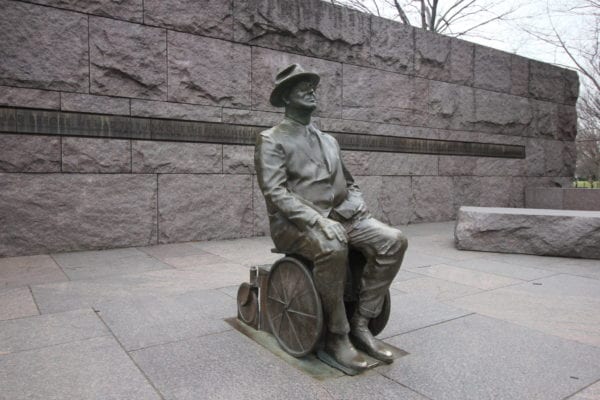
This life-sized depiction of Franklin Delano Roosevelt in his wheelchair was the result of a 3-year debate after the memorial was opened in 1997.
Originally, Lawrence Halprin and the other memorial designers decided not to represent FDR in a wheelchair, since the President himself went to great lengths to hide his disability.
However, the National Organization on Disability widely criticized the memorial for representing a historically incomplete picture of the President.
Memorial officials first attempted to quell criticism by adding casters to the chair statue that you will see in the third room. That did not satisfy disability advocates.
So, the National Organization on Disability raised over 1.6 million dollars to fund the addition of the prologue room, which includes the statue depicting clearly FDR in his wheelchair, welcoming visitors to the memorial.
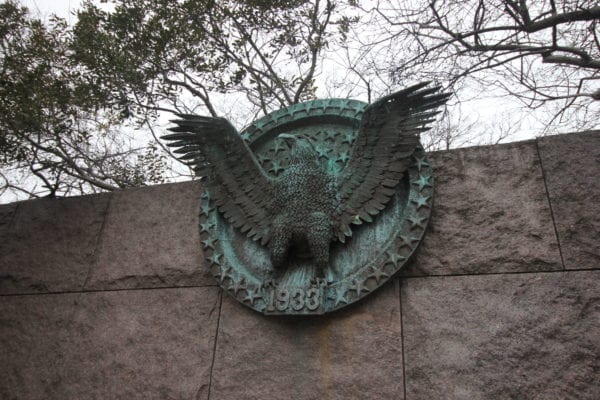
Walk around the right side of the wall in front of you, and notice the bronze-cast Presidential Seal as you enter the first room of the memorial.
First Term 1933-1937
The first room in the FDR Memorial represents the Great Depression and the hopefulness that his election to the presidency meant to many Americans.
Seven quotes, all taken from his inaugural address, refer the Great Depression and are inscribed into the surrounding walls, including FDR’s most famous quote “The only thing we have to fear is fear itself.”
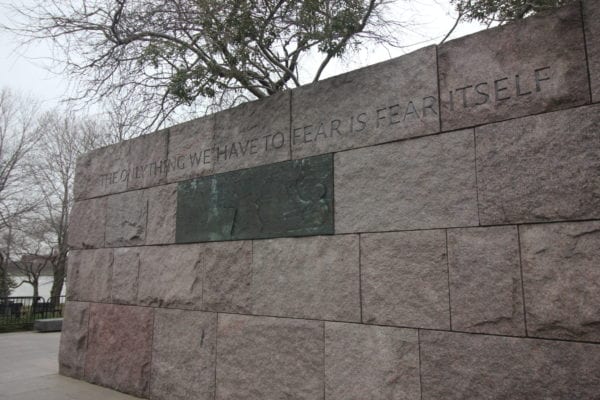
During this speech, Roosevelt addressed the economic crisis, staggering unemployment rates, and foreign policy.
His confident and direct oratory style gave American’s assurance during a time of extreme financial instability.
Under that quote is a bronze relief depicting his inaugural parade.
The water feature for this first room is a single strong waterfall, representing the crash of the Great Depression.
Continue through the memorial to the second room; notice the inscription in the ground as you move into FDR’s second presidential term.
Second Term 1937-1941
The central focus of FDR’s second term was developing and executing the New Deal, a system of job programs funded and organized by the federal government in partnership with states, intended to bring the country out of economic turmoil.
In this room, there are three scenes depicting the state of American citizens in the United States during the Great Depression.

In front of you, against the large central wall, a rural farming family is depicted suffering from the effects of drought, dust bowls, and poverty.
A bread line is also shown, representing the poverty and desperation of the urban working class during the Great Depression.
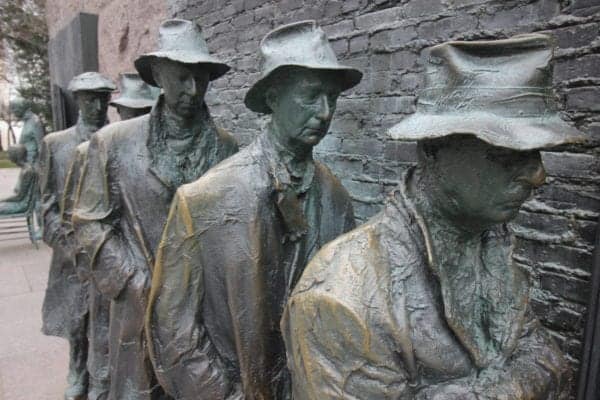
Inscribed above the sculptures is the following quote from FDR’s second inaugural address: "I see one-third of a nation ill-housed, ill-clad, ill-nourished.”
The sculpture to the right depicts a man listening to one of Roosevelt’s fireside chats.
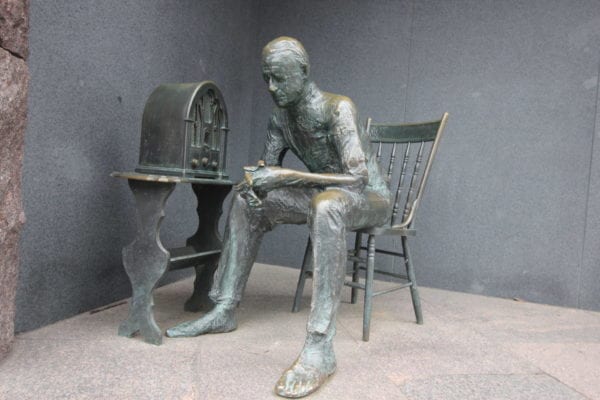
FDR gave thirty public addresses over the radio between 1933 and 1944, communicating directly with the American public for the first time in US presidential history.
Over the radio, FDR spoke simply and clearly, addressing national issues with straightforward language and direct explanations.
These broadcasts allowed FDR to intimately connect with Americans in their homes—he earned the trust of the Nation and reassured the country during times of economic upheaval and world war.
This tradition is carried on to this day through the President’s weekly address, usually posted online and broadcast on the radio.

Continue straight, around the right side of the central wall, and you will see a large stepped waterfall directly in front of you with six columns standing in the center of the room.
These columns are meant to represent FDR’s New Deal, depicted as rolls of an industrial printing press.
The negative images are shown wrapped around the columns and then “imprinted” on the wall to your left as bronze reliefs.
The more than 2 dozen images show examples of New Deal programs that FDR pushed to enact to help the United States out of the Great Depression.

These tactile reliefs are meant to be interactive for the blind and include Braille captions throughout.
The large stepped waterfall represents the Tennessee Valley Authority (TVA) dam-building projects, which helped stimulate the economy and electrify an area hard hit by the economic collapse.
The waterfall is now bigger and more elaborate. In a way, the TVA represented an evolution in the new deal, from funding small, locally controlled projects to more federal control involving multiple states in one endeavor.
Walk around to the left to enter the third room, noting the inscription on the ground.
Third Term 1941-1945
FDR’s third term as President brought the United States into World War II.
The broken slabs of granite scattered along the ground represent the confusion and struggle that WWII created, with the quote “I hate war” inscribed on the blocks.
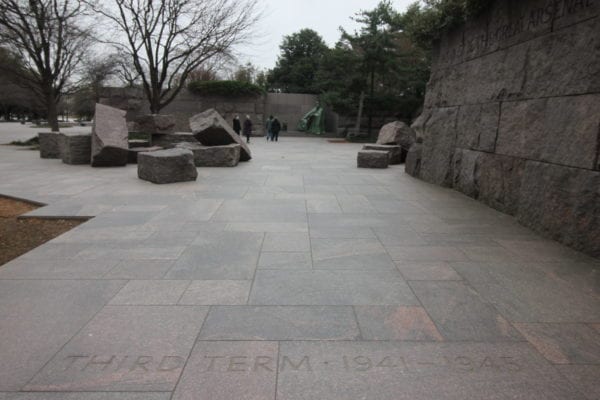
You should also notice the waterfall, now not only larger and steeped but also chaotic, in disorder, reflecting the disorderly state of international affairs at the time.
Beyond the stones is a large sculpture of FDR and his beloved pet dog, Fala (the only presidential pet to be memorialized).
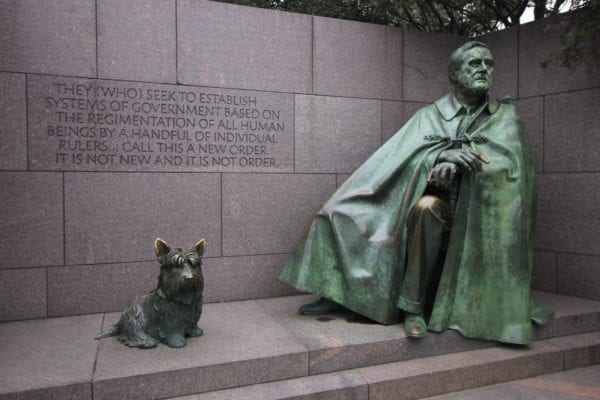
This is the memorial's original FDR statue, depicting him at the Yalta Conference, just months before his death, with a cloak obscuring his chair.
If it seems familiar, it's because it's a depiction of him in a famous of him with Joseph Stalin and Winston Churchill seated next to him (minus the cigarette).
As mentioned in the prologue room summary, this statue was the subject of controversy, even after metal castors were added to represent the wheelchair.
Interestingly, the depiction of FDR is correct. In the Yalta Conference image, he is sitting in a regular chair.
You will also notice that FDR’s pointer finger and Fala’s ears are shiny gold, as visitors have been touching and taking pictures with the bronze sculptures since 1997.
Continue along to the left to enter the fourth and final room of the memorial.
Fourth Term 1945 Room
Walk down the ramp to your right to enter FDR’s fourth term, which was punctuated by the President’s death on April 12th, 1945.
At the middle of the ramp is a still pool of water with a relief above depicting the President’s funeral procession.
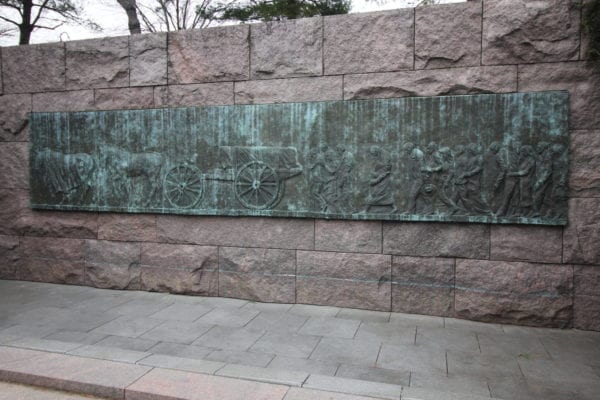
Still water, representing serenity and reflection, is common at memorials when representing death.
Continue down the ramp and enter the main area of the memorial.
To your right is a statue of First Lady Eleanor Roosevelt with a United Nations emblem behind her.
This is the only presidential memorial to honor a First Lady. It also commemorates her contributions to the UN and human rights causes.
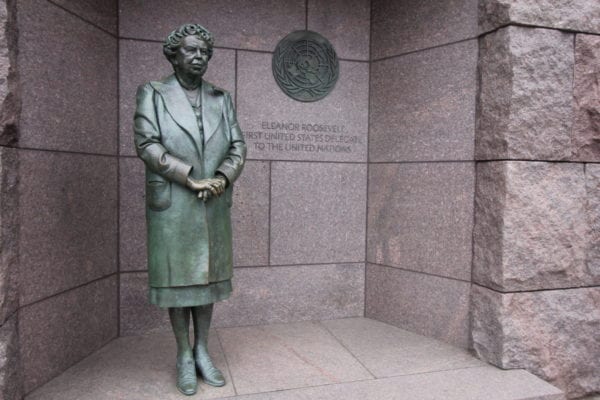
As this memorial is not just a memorial to FDR but to the American public and what we went through together as a country at the time, this final room brings together everything.
You'll find still water, chaotic and stepped waterfalls, and a single strong waterfall - the types of water feature you saw earlier through the memorial.
Carved into the steps to the left, exiting the memorial, there is a brief timeline of events in FDR’s life.
The last quote of the memorial, engraved onto the wall to your right as you exit, is taken from FDR’s January 6th, 1941 State of the Union Address, when the country was on the precipice of entering World War II.
In this speech, Roosevelt listed the “Four Freedoms” that American’s would be fighting for overseas:
- Freedom of Speech
- Freedom of Worship
- Freedom from Want
- Freedom from Fear
RELATED POSTS:
